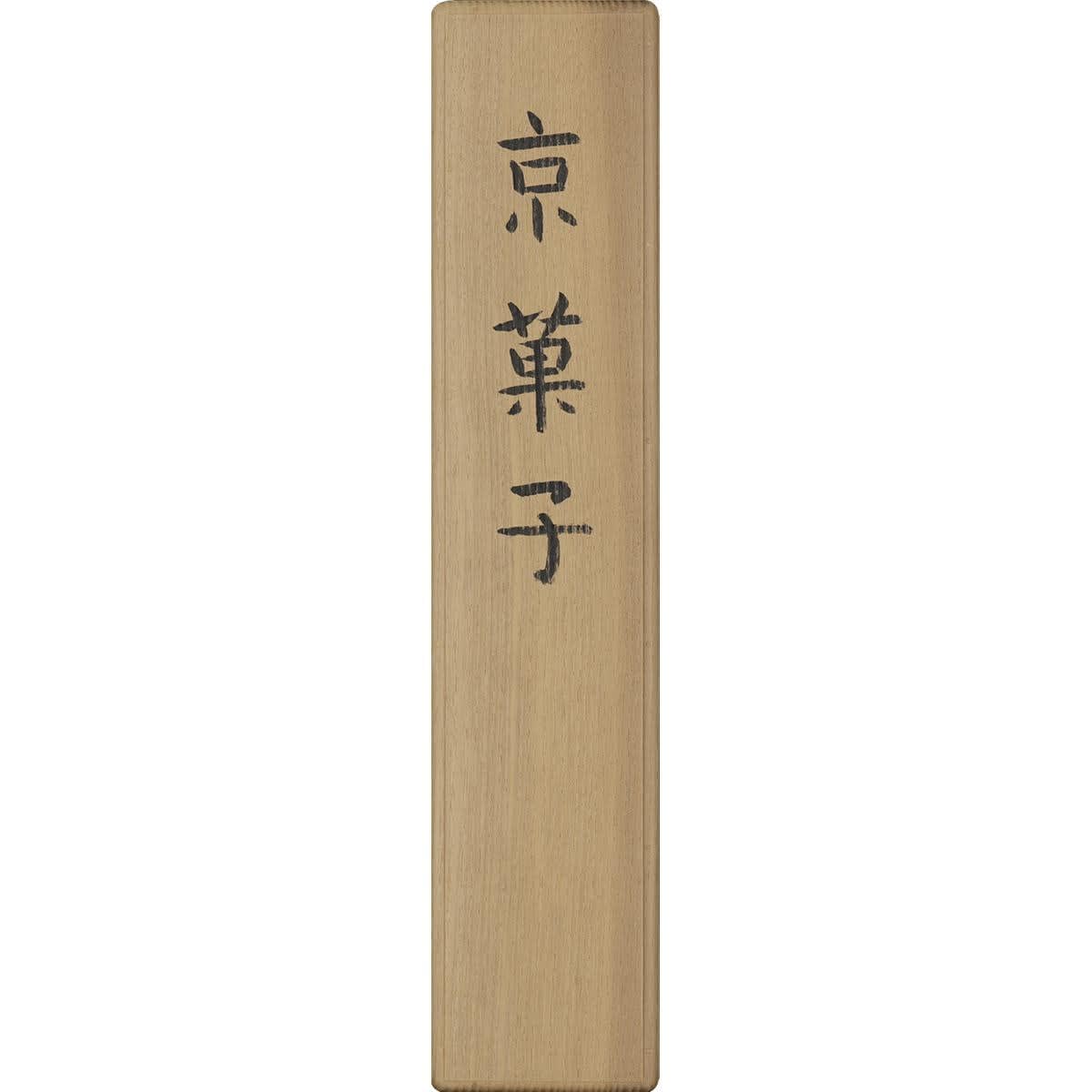Fukuda Heihachirō (1892–1974)
Kyogashi
Color and gold on paper, hanging scroll
With a box signed by the artist, double boxed
Seal: Hei
27.2 x 24.4 cm
115.5 x 37.5 cm (overall)
Further images
The word kyogashi can be translated as ‘Kyoto sweets,’ though confectionary is too small a category to truly encompass the significance of these culinary delights. Kyogashi inherited the traditions of Heian-period yusoku-gashi sweets. They blossomed under the resurgence of courtly culture and the emergence of the tea ceremony to become a representative example of the Kyoto culture, then further developed and diversified in great bounds during the late Edo period, from the Bunka and Bunsei eras. This painting depicts four such Japanese sweets alongside a stick of sweet dango dumplings. However, they are not portrayed as they would be when offered on a plate to a visiting customer or when presented on gold paper. Rather, Heihachiro has arranged them carefully based on a consideration of the aesthetic value of their respective positions, with the shapes and colors also selected from the point of view of a trained confectionary maker. The viewer is struck by the affectionate plum and autumn-leaf shapes of the sweets. The elegant tones also exude a double-layered beauty, with the kyogashi colors appreciated alongside the beautiful hues of the clear nihonga pigments.
Even today, this confectionary is still cherished by Kyotoites for the way it exudes a sense of the changing seasons, from the hanabiramochi rice cake eaten at the start of the year and the hichigiri sweets made for the Girls’ Festival, to the kashiwamichi rice cakes prepared for the Boys’ Festival and the minazuki rice cakes enjoyed during the Nagoshi no harae summer festival, for instance. Even for people who usually avoid sweets, these kyogashi delight in the way they convey a sense of the changing seasons while engendering an appreciation for nature and the spiritual world.
When Fukuda Heihachiro was nineteen, he left Oita and came to Kyoto to study nihonga. For a country boy, the new climate, humidity, dialects, clothing and customs of Kyoto must have made a striking impression. During his long life in Kyoto, Heihachiro was constantly captivated by the refined beauty of kyogashi and the sheer craftsmanship and ingenuity involved in producing their exquisite tastes. As such, he often painted small, elegant works like this. Heihachiro observed all around him with the same level of intensity, from old paintings and masterpieces at Kyoto National Museum to wrapping paper for cheap candy. He believed this wide-ranging outlook allowed him to capture the true beauty of things.
Fukuda Heihachiro (nihonga painter; 1892–1974)
Born in Oita Prefecture in Kyushu, Fukuda graduated from the Kyoto City School of Arts and Crafts and continued his studies at Kyoto Municipal School of Painting. His early works rely on a naturalist approach with a bold sense of color. He would later move towards lighter tones, which together with his strong sense of composition garnered him a central position in the art world. Together with Nakamura Gakuryo, Makino Torao and others he co-founded the Rikuchokai art association. A member of the Japan Art Academy, Fukuda also served as an adviser to the Nitten exhibitions and a professor at the Kyoto Municipal School of Painting. Designated a honoray citizen of Oita, Person of Cultural Merit, and receiver of the Order of Culture.
Even today, this confectionary is still cherished by Kyotoites for the way it exudes a sense of the changing seasons, from the hanabiramochi rice cake eaten at the start of the year and the hichigiri sweets made for the Girls’ Festival, to the kashiwamichi rice cakes prepared for the Boys’ Festival and the minazuki rice cakes enjoyed during the Nagoshi no harae summer festival, for instance. Even for people who usually avoid sweets, these kyogashi delight in the way they convey a sense of the changing seasons while engendering an appreciation for nature and the spiritual world.
When Fukuda Heihachiro was nineteen, he left Oita and came to Kyoto to study nihonga. For a country boy, the new climate, humidity, dialects, clothing and customs of Kyoto must have made a striking impression. During his long life in Kyoto, Heihachiro was constantly captivated by the refined beauty of kyogashi and the sheer craftsmanship and ingenuity involved in producing their exquisite tastes. As such, he often painted small, elegant works like this. Heihachiro observed all around him with the same level of intensity, from old paintings and masterpieces at Kyoto National Museum to wrapping paper for cheap candy. He believed this wide-ranging outlook allowed him to capture the true beauty of things.
Fukuda Heihachiro (nihonga painter; 1892–1974)
Born in Oita Prefecture in Kyushu, Fukuda graduated from the Kyoto City School of Arts and Crafts and continued his studies at Kyoto Municipal School of Painting. His early works rely on a naturalist approach with a bold sense of color. He would later move towards lighter tones, which together with his strong sense of composition garnered him a central position in the art world. Together with Nakamura Gakuryo, Makino Torao and others he co-founded the Rikuchokai art association. A member of the Japan Art Academy, Fukuda also served as an adviser to the Nitten exhibitions and a professor at the Kyoto Municipal School of Painting. Designated a honoray citizen of Oita, Person of Cultural Merit, and receiver of the Order of Culture.









